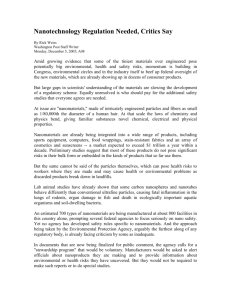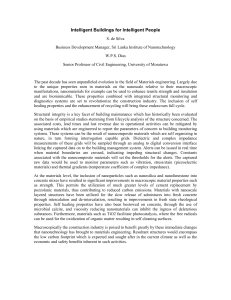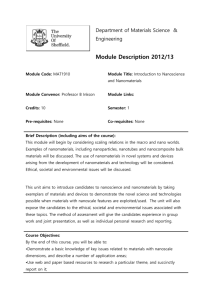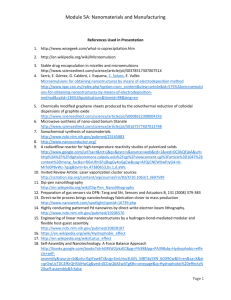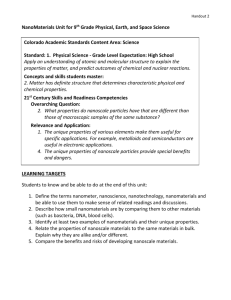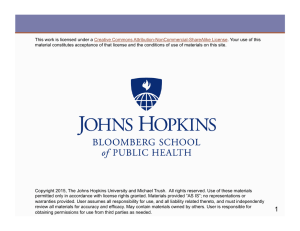sustainability Sustainable Nanotechnology: Through Green Methods and Life-Cycle Thinking
advertisement
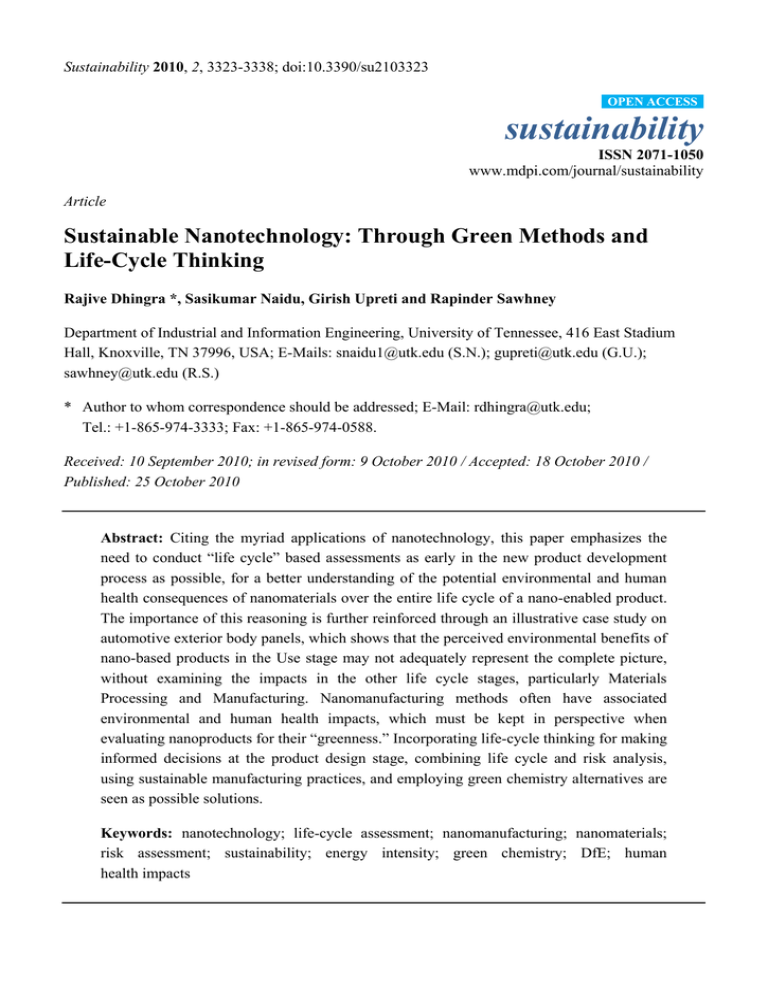
Sustainability 2010, 2, 3323-3338; doi:10.3390/su2103323 OPEN ACCESS sustainability ISSN 2071-1050 www.mdpi.com/journal/sustainability Article Sustainable Nanotechnology: Through Green Methods and Life-Cycle Thinking Rajive Dhingra *, Sasikumar Naidu, Girish Upreti and Rapinder Sawhney Department of Industrial and Information Engineering, University of Tennessee, 416 East Stadium Hall, Knoxville, TN 37996, USA; E-Mails: snaidu1@utk.edu (S.N.); gupreti@utk.edu (G.U.); sawhney@utk.edu (R.S.) * Author to whom correspondence should be addressed; E-Mail: rdhingra@utk.edu; Tel.: +1-865-974-3333; Fax: +1-865-974-0588. Received: 10 September 2010; in revised form: 9 October 2010 / Accepted: 18 October 2010 / Published: 25 October 2010 Abstract: Citing the myriad applications of nanotechnology, this paper emphasizes the need to conduct ―life cycle‖ based assessments as early in the new product development process as possible, for a better understanding of the potential environmental and human health consequences of nanomaterials over the entire life cycle of a nano-enabled product. The importance of this reasoning is further reinforced through an illustrative case study on automotive exterior body panels, which shows that the perceived environmental benefits of nano-based products in the Use stage may not adequately represent the complete picture, without examining the impacts in the other life cycle stages, particularly Materials Processing and Manufacturing. Nanomanufacturing methods often have associated environmental and human health impacts, which must be kept in perspective when evaluating nanoproducts for their ―greenness.‖ Incorporating life-cycle thinking for making informed decisions at the product design stage, combining life cycle and risk analysis, using sustainable manufacturing practices, and employing green chemistry alternatives are seen as possible solutions. Keywords: nanotechnology; life-cycle assessment; nanomanufacturing; nanomaterials; risk assessment; sustainability; energy intensity; green chemistry; DfE; human health impacts Sustainability 2010, 2 3324 1. Introduction Sustainability and futures studies are linked to each other; the time scales involved may be different from the individual viewpoints of stakeholders, depending on whether they are futurists or environmentalists [1]. Futures thinking calls for planning in the time scale of hundreds of years whereas the environmental research community may think in terms of a few decades at the most [2]. Sustainability of new technology is a key issue these days, be it genetically modified foods, stem cell research or nanotechnology. The burgeoning field of nanotech applications has left us with no doubt that nano-enabled products will play a dominant role in global manufacturing in the not-so-distant future. With new applications being discovered every day in areas as diverse as medicine, automotive, energy, agriculture, and entertainment, we are becoming increasingly aware of the benefits of nanotechnology in terms of cost and energy savings, increased productivity, increased efficiency, as well as reduced environmental impacts. According to Lux Research, the total revenue from products incorporating nanotechnology is expected to be $2.5 trillion in 2015, even though this estimate is down 21% from their previous projections [3], the downward revision being made considering the global economic downturn, as a result of which the rate of nanotech adoption was expected to be somewhat slower than originally anticipated. A nanometer is one-billionth of a meter. According to the National Nanotechnology Initiative, a program established in 2001 to coordinate federal nanotechnology research and development, nanotechnology is the ―the understanding and control of matter at dimensions between approximately 1 and 100 nanometers, where unique phenomena enable novel applications. Encompassing nanoscale science, engineering, and technology, nanotechnology involves imaging, measuring, modeling, and manipulating matter at this length scale [4].‖ Nanotechnology is considered an all-pervasive ―enabling‖ technology [5] that transcends sectoral boundaries, resulting in novel applications of nanomaterials that promise radical improvements in various spheres of life. Examples include paper-thin, high-energy, nanoengineered batteries. Capable of being folded and cut like paper and infused with carbon nanotubes, these sheets of nanocomposite paper serve as ultra-thin, flexible batteries and energy storage devices for next-generation electronics and implantable medical equipment [6]. Nano-enabled miniaturized diagnostic devices can be implanted in the human body for early diagnosis of illnesses, and the use of nanotechnology for in-vivo drug delivery and imaging systems is expanding rapidly [7]. Nano-based coatings can improve the bioactivity and biocompatibility of implants [8], while nanocoatings are also finding use in corrosion-resistance, dirt repellency, water repellency, thermal insulation, and anti-microbial applications. Applications of nanotechnology that directly benefit the environment are nanotechnologies for site remediation and wastewater treatment [9], nanomaterial-based solar cells for improved energy efficiency, the use of nanocatalysts for air purification [10], and nanostructured filters or nanoreactive membranes for water purification [11]. Despite the seemingly obvious benefits of nanotechnology, there could be unintended health and environmental risks associated with the widespread use of nanomaterials which might not have yet been fully understood. As discussed in the following sections, there is a need to use a life-cycle based approach, possibly combined with risk assessment, in order to better understand the potential problems, Sustainability 2010, 2 3325 and to adopt green nanomanufacturing methods that are less burdensome to the environment and human health. 2. Nanomanufacturing Methods and Environmental Concerns Nanoscale manufacturing involves one of two approaches: top-down or bottom-up. The top-down approach starts with micro-systems and miniaturizes them, through carving or grinding methods, such as lithography, etching, or milling. Bottom-up methods mimic nature by starting at the atomic or molecular level and building ―up‖ through nucleation and/or growth from liquid, solid, or gas precursors by chemical reactions or physical processes. Examples of techniques include sol-gel or epitaxy [8,12]. It is generally believed that top-down methods generate a lot more waste. Though the bottom-up approach is in its early development phase, it promises sweeping changes to current methods of production. Nanostructured materials can be classified as one-dimensional (1D), two-dimensional (2D), or three-dimensional (3D). Examples of 1-D nanoproducts are thin films and coatings, while 2-D include nanotubes and nanorods, and 3-D nanoproducts include fullerenes and nanoparticles. The production of 2-D and 3-D nanoproducts, generally, has stricter purity requirements. Many of the processes required to manufacture them have low process yields and, therefore, low material efficiencies, resulting in excessive waste. Moreover, these processes usually consume large quantities of energy, water, and solvents. In addition to being excessively resource and energy intensive, some of these processes have the potential to cause unintended acute and chronic human health impacts, from accidental exposure to nanomaterials. Sengül et al. [12] have discussed various nanomanufacturing methods and have summarized the characteristics of nanomanufacturing processes that make them energy and resource intensive as follows: Stricter purity requirements Lower process yields Repeated processing, post processing or reprocessing steps of a single process or batch Use of toxic, acidic or basic chemicals and organic solvents Need for moderate to high vacuum Use of or generation of greenhouse gases The authors would like to refer the reader to the Sengul et al. article for an in-depth analysis of the issues pertaining to nanomanufacturing methods for 1-D, 2-D and 3-D nanostructured materials. The manufactured quantities of nanomaterials are expected to increase as the technology becomes pervasive and starts displacing conventional materials in products. The starting materials used in manufacturing processes are usually rare and involve resource intensive extraction or processing that puts additional strain on natural resources and increases the overall life cycle environmental impact of the product they are ultimately used in, as demonstrated in a case study that follows. This raises the issue of finding suitable starting materials for nanomanufacturing methods. Sustainability 2010, 2 3326 3. Industrial Ecology and LCA Industrial Ecology is a systems approach that provides a holistic view of environmental problems, and helps us understand the way humans use natural resources in the production of goods and services. It emphasizes the need to study the interactions of industrial systems with the environment, and to design products and manufacturing processes in a way that optimizes the use of by-products, maximizes recycling, and minimizes waste [13]. This approach strives to ensure that industrial growth in the future is sustainable and in harmony with the environment. The foregoing discussion leads us right to the definition of Sustainable Development which, according to a World Commission on Environment and Development (WCED) report of 1987, is ―Development that meets the needs of the present without compromising the ability of future generations to meet their own needs” [14]. The wide-ranging applications of nanotechnology have an equally widespread potential to adversely affect human health and the environment, through various exposure routes of nanoparticles [15], including occupational exposure [16]. Despite early calls to adopt measures that would ensure the sustained growth of nanotechnology, little has been done so far, in the unrelenting quest to rapidly introduce more and more novel nano-applications [17]. Life-Cycle Assessment (LCA) is an invaluable tool for assessing the environmental impacts associated with the entire life cycle of a product. In fact, it would be premature to make any claims on the environmental benefits of a product or manufacturing process without first considering its environmental consequences in a ―life-cycle‖ context. The steps typically involved in an LCA are (1) defining the goals and scope of the assessment, (2) quantifying the material and energy inputs, as well as the environmental releases for each unit process that forms part of the assessment (known as Life-Cycle Inventory or LCI), (3) evaluating the potential human health and environmental impacts associated with the inputs and outputs identified in the LCI data collection step, and (4) interpreting the results, highlighting significant issues, drawing conclusions and making recommendations [18]. The life cycle stages usually considered are Material Extraction, Processing, Manufacturing, Use, Transportation, and End-of-Life (Recycling/Disposal). Conducting a life-cycle assessment of conventional products is in itself a daunting task, with boundaries often having to be drawn to limit the scope of the assessment, in order to complete it within a reasonable amount of time, with the finite resources available. Some of the methods available for curtailing the scope of the assessment (also known as LCA streamlining) include (i) restricting it to certain life-cycle stages of interest, for example, the Use stage, (ii) identifying certain environmental impact categories of particular relevance, such as Global Warming, or (iii) just conducting a comparative study of two different manufacturing processes that result in the creation of otherwise identical products. With nanomaterials, the task of conducting a life-cycle assessment becomes even more difficult because of lack of available inventory data on these materials, since their manufacturing processes are new and often subject to confidentiality constraints [19]. Another reason for not being able to use inventory data the same way as in the case of conventional materials is that cutoffs based on mass alone do not make sense for nanoparticles [15]. Also, current impact assessment methodologies do not incorporate formulas for computing the health and environmental effects of nanomaterials, simply because these effects are not yet fully known. Moreover, manufacturing processes for the production of nanomaterials are not yet standardized, but are in an evolutionary stage, changing constantly. For Sustainability 2010, 2 3327 this reason, the environmental impacts associated with Production Method A for a given product could vary considerably from those associated with Production Method B. In the case of new technologies such as these, which are in their developmental phase, it might be beneficial to conduct scenario analyses when performing LCAs, for addressing uncertainties in possible future outcomes. In spite of the challenges faced in conducting LCAs of nanomaterials, a number of LCAs have been attempted [20-25], and even if complete LCAs cannot be performed, it is important to take a life-cycle view of new technologies such as these, to help bring to light any issues or concerns in any of the upstream or downstream stages that may be elusive at first. This ―life-cycle thinking‖ approach needs to be applied at an early stage in the product development process, in order to better understand the environmental implications of new technologies and to be able to make informed decisions on the benefits or drawbacks of one alternative over another. There have been several suggestions to apply the life cycle thinking approach to nanotechnology development [15,26-28]. Recognizing the drawbacks of LCA in being inadequate for analyzing the health effects and exposure routes of nanoparticles, this paper later describes more appropriate frameworks that combine the LCA approach with Risk Assessment (RA). The two frameworks discussed are nanoLCRA (Life Cycle Risk Assessment) and Comprehensive Environmental Assessment (CEA). Likely environmental impacts during each life-cycle stage of nano-enabled products are presented in Figure 1. Figure 1. Life-Cycle of Nanomaterials (Simplified). The apparent benefits of nano-enabled products, usually in the ―Use‖ stage, often take center stage, while the environmental problems associated with the remaining upstream and downstream life-cycle stages tend to get overlooked [27]. Of particular concern are the Materials Processing and End-of-Life (Recycling/Disposal) stages. The creation of nanomaterials can often be highly energy and resource intensive, as discussed earlier in Section 2. At the End-of-Life stage, we are confronted with the problem of disposing of the nano-enabled product, if it is not fully recyclable and/or reusable. Sustainability 2010, 2 3328 Manufactured nanomaterials have the potential to be released to the environment at each stage of the product life cycle [29]. 4. Energy Intensity of Carbon Nanofibers and Nanoparticles Although aluminum is thought to be one of the most energy intensive materials to produce, it has highly desirable properties, namely, light weight and higher strength as compared to steel, the material it usually competes with. Another drawback of aluminum is its higher price, but both the price and higher energy intensity do not usually come in the way of its use in certain critical aerospace, automotive and other applications. Because of its high energy intensity, aluminum has become a kind of yardstick by which some other, newer, materials are evaluated for their energy intensities. Carbon nanoparticles and nanofibers are examples of such materials that are much more energy intensive to produce than aluminum. Two recent studies, one on nanofibers and the other on nanoparticles, show that carbon nanofibers produced from a range of feedstock materials require 13 to 50 times the energy required for the production of primary aluminum on an equal mass basis [30], while the carbon nanoparticles study finds their energy intensity to be 2 to 100 times that of aluminum [31]. When selecting conventional (non-nano) materials for use in a new product or application, product designers have traditionally been confronted with issues like strength, performance, cost and aesthetics. More recently, keeping the principles of Design for the Environment (DfE) in mind, additional environmental considerations like energy intensity, toxicity, recyclability, and ease of disassembly have made their way into their list of design criteria. The advent of nanomaterials, however, has necessitated a change in the traditional material selection process, because now product designers will not only have to keep the above issues in consideration but will also have to think about the health and safety of those who might be exposed to these nanoscale materials that have the potential to be inhaled or to penetrate the skin, and possibly affect vital organs. 5. Automotive Body Panels: A Case Study The results from one of the author’s previous studies have been used to show how nano-based products that seem environmentally preferable over other alternatives in the Use stage may not actually turn out to be so when the whole life cycle is considered. The original study compared lightweight alternatives to exterior body panels in vehicles of the future [32,33]. Aluminum, carbon fiber reinforced polymer (CFRP) composite, and glass fiber reinforced polymer (GFRP) composite were considered as alternatives to steel closure panels (consisting of the 4 doors, hood, and deck lid) in a baseline vehicle [34]. The data for that study (which we will refer to as the ―exterior body panels‖ study) were based on carbon fiber produced from polyacrylonitrile (PAN) precursor fiber, which is oxidized and carbonized into carbon fiber by exposing it to progressively higher temperatures in the presence of nitrogen. We have substituted the energy required to produce the PAN-based carbon fiber with the energy required to produce carbon nanofiber, the data for which have been taken from a recent study on carbon nanofiber production [30], performed by Khanna et al., based on vapor grown fibers synthesized from three different hydrocarbon feedstocks—methane, ethylene, and benzene, using the Sustainability 2010, 2 3329 average energy of the range provided in the study (2,872–10,925 Mega Joules/kg). Thus, the carbon fiber reinforced polymer (CFRP) composite in the exterior body panels study has been replaced with carbon nanofiber reinforced polymer (CNFRP) composite material, focusing only on the life-cycle energy requirements. The major assumptions of the previous study are stated in Table 1. Table 1. Exterior Body Panels Study—Major Assumptions. Mass of the baseline (1994 Taurus class) vehicle 3,248 lbs Useful life of vehicle 120,000 miles Life of body panels Equal to life of vehicle Baseline vehicle fuel efficiency 26.6 mpg Mass of steel closure panels 220 lbs Material substitution factor for CFRP 0.4 CFRP composition 30% CF in epoxy resin Secondary weight savings factor 1.5 Fuel efficiency improvement factor 0.7* Gasoline density 6.154 lbs/gallon Gasoline heat content 115,400 BTUs/gallon * Vehicle fuel efficiency improves by 7% for each 10% reduction in vehicle weight [21]. Based on the above assumptions, using a material substitution factor of 0.4 for CFRP [35], it was estimated that the weight of CFRP panels would be 88 lbs if they were to replace 220 lbs of steel, resulting in overall weight savings of 132 lbs. However, any major weight reduction in vehicle weight provides opportunities for additional weight reductions in other components (known as secondary weight savings). Taking the secondary weight savings into account, the overall weight savings go up to 198 lbs, bringing the CFRP vehicle weight down to 3,050 lbs. Applying the fuel efficiency improvement factor of 0.7 to the baseline vehicle fuel efficiency of 26.6 mpg, the fuel efficiency of the CFRP vehicle was calculated to be 27.74 mpg. This works out to 4,327 gallons of gasoline used by the CFRP vehicle over its lifetime, as against 4,511 gallons by the baseline vehicle. Since the functional unit for the exterior body panels study was not the whole vehicle, but only the closure panels driven over the lifetime of the vehicle, the quantity of gasoline consumed on account of the body panels alone is the fractional ratio of the mass of CFRP closure panels to the whole car, or 124.8 gallons. This translates to 768 lbs, embodying an energy content of 14.40 million BTUs (MMBTUs). The Energy use results from the exterior body panels study, as well as the modifications incorporating carbon nanofibers in place of bulk carbon fibers, are presented in Table 2. It has been assumed that the CNFRP composite will require only half the mass of carbon fibers, as compared to the CFRP composite material in the original study, because of the much higher strength of nanofibers. The 70/30 epoxy/carbon fiber mix in the original study, therefore, has been replaced with an 85/15 epoxy/carbon nanofiber mix, requiring only 13.2 lbs of nanofiber in 88 lbs of CNFRP panels. In estimating the energy requirements of CNFRP panels, the additional energy required to produce nanofibers has been taken into account, based on an average value of 6,899 MegaJoules/kg (taken from the study by Khanna et al., as described above), as well as the energy required to produce the additional quantity of epoxy resin in the mix. Sustainability 2010, 2 3330 Table 2 shows the results of the previous study, along with an additional row representing the new CNFRP analysis (in bold). It is observed that the only change in energy numbers for CNFRP over CFRP is in the Extraction & Materials Processing (E&MP) stage, on account of the additional energy required to produce carbon nanofibers, with everything else remaining the same. In the previous study, CFRP turned out to be the material of choice, not only on account of its lowest total life-cycle energy requirement, but also because it was less environmentally burdensome in 8 other environmental impact categories (not shown here), out of a total of 14 impact categories evaluated [32,33]. Table 2. Energy Use for Exterior Body Panels by Life-Cycle Stages. Energy Use (MMBTUs) E&MP Use— Fuel Use Use— Fuel Prod. EOL Total Steel Aluminum GFRP CFRP CNFRP 1.19 12.97 2.00 4.53 43.67 35.25 19.69 24.58 14.40 14.40 7.78 4.35 5.43 3.18 3.18 0.01 0.02 0.01 0.00 0.00 44.24 37.02 32.02 22.11 61.26 It is noteworthy that, while the Use (driving) stage typically dominates the environmental life cycle of the automobile, accounting for about 80% of the environmental impacts, substituting the body panels with nanofiber-based material, albeit in a small quantity, makes the Use stage seem insignificant compared to the Extraction and Materials Processing stage. In the previous assessment, aluminum was the most energy intensive material to produce, with its E&MP stage accounting for 35% of the life-cycle energy impacts. However, the introduction of CNFRP makes the E&MP stage for this material the biggest contributor to total life-cycle energy, as depicted in Figure 2. In fact, the use of nanofibers totally turns the results of the study around, to make this choice of material the worst, at least on the energy front. The above study clearly indicates that newer materials that are being chosen have numerous advantages, by way of their high strength, light weight, etc., but are also likely to have a relatively higher energy and material resource intensity in the upstream processing stages. In order to derive maximum benefit from the use of these materials in an environmentally responsible manner, we need to look at ways in which we can reduce their environmental burden in the life-cycle stages prior to the Use stage. Since the above results are based on the assumption that half the quantity of carbon nanofibers will be needed in the CNFRP composite as compared to the CFRP material, a sensitivity analysis was conducted using higher and lower percentages of carbon nanofiber in the epoxy resin mix. Values of 10% and 20% by mass of carbon nanofibers were utilized to calculate the changes in the energy consumption. The energy required by the 3 different compositions of CNFRP in the Extraction and Materials Processing stage is graphically depicted in Figure 3, which also shows comparisons with the energy requirements of the other competing materials. Sustainability 2010, 2 3331 Figure 2. Contribution of the Extraction & Materials Processing Stage to Total Life-Cycle Energy. Extraction & Materials Processing as Percentage of Total Energy 71% 80% 70% 60% 50% 35% 40% 20% 30% 20% 6% 3% 10% 0% Steel Aluminum GFRP CFRP CNFRP Figure 3. Comparison of Extraction & Materials Processing Energy. Million BTUs Extraction & Materials Processing Energy - CNFRP Sensitivity 60 50 40 30 20 10 0 57 44 31 13 1 5 2 It is observed that in spite of varying the quantity of carbon nanofibers in the epoxy composite mix, the E&MP energy of the nanocomposites is still much higher than that of the other materials, with the nanofibers continuing to play a dominant role in the total energy requirement. Noting that the purpose of vehicle weight reduction is to maximize fuel economy, with a corresponding decrease in fuel use, it is seen that in the case of all three CNFRP compositions, the benefit of reduced fuel use is negated by the high energy required for the production of these materials. This is clearly understood by taking a Sustainability 2010, 2 3332 look at the total energy results for the various CNFRP compositions compared to the four competing materials, steel, aluminum, GFRP, and CFRP, as shown in Table 3. Table 3. Energy Use Sensitivity to CNFRP Composition. Energy Use (MMBTUs) E&MP Total Steel Aluminum GFRP CFRP CNFRP (10%) CNFRP (15%) CNFRP (20%) 1.19 12.97 2.00 4.53 30.78 43.67 56.57 44.24 37.02 32.02 22.11 48.36 61.26 74.15 In the case of the 10% CNFRP material, the total energy approaches the baseline vehicle energy of 44 MMBTUs. However, it is the strength of carbon nanofibers and the mechanics of the nanofiber-matrix interface that ultimately determine the quantity of nanofibers in the epoxy resin mix. For comparison, aluminum has a tensile strength of 110 MegaPascals (MPa), with carbon nanofiber being approximately 50 times stronger, having a tensile strength of 5,000 MPa, or 5 GigaPascals (GPa). Carbon nanofiber is also about 10–15 times stronger than the grade of steel used for automotive body panels (which has a tensile strength of about 400 MPa) [36,37]. A study conducted on the strength of carbon nanofiber-epoxy composites estimates the minimum interfacial strength of the nanofiber-epoxy composite system to be 170 MPa [37]. Carbon Nanotubes (CNTs), on the other hand, are much stronger than even carbon nanofiber, with a tensile strength in the range of 30–200 GPa [38]. In addition to being highly energy-intensive, nanomanufacturing processes can be highly resource-intensive, too. Certain nanomaterials require a practically contaminant-free environment, such as clean rooms and ultrapure water. Nanomanufacturing methods and the environmental concerns associated with them are discussed earlier in Section 2. 6. Proposed Solutions Considering that the production of nanomaterials could be environmentally burdensome, and that there are potential health and safety concerns associated with their production, it is important for us to study the tradeoffs involved by weighing the prospective benefits of nano-based products against their unintended negative impacts. Compounding the problem is the fact that existing policies regulate only conventional chemical substances, and there is no obligation on the part of manufacturing companies to label nanomaterials on their products [39]. Potential solutions are seen in the form of greener nanosynthesis methods, which we call ―Green Alternatives,‖ and assessment frameworks that combine life cycle and risk assessment, such as Comprehensive Environmental Assessment (CEA) and Life Cycle Risk Assessment (LCRA). These are discussed in the following sub-sections. Sustainability 2010, 2 3333 6.1. Green Alternatives Michael Berger of Nanowerk LLC [40] has suggested a potential solution by applying the following principles of green chemistry, as outlined by the US Environmental Protection Agency (EPA) on their ―Green Chemistry‖ website, to nanomanufacturing processes. 1. Design chemical syntheses to prevent waste 2. Design safer chemicals and products 3. Design less hazardous chemical syntheses 4. Use raw materials and feedstocks that are renewable 5. Minimize waste by using catalytic reactions 6. Avoid chemical derivatives 7. Maximize atom economy 8. Use safer solvents and reaction conditions 9. Increase energy efficiency 10. Design chemicals and products to degrade after use 11. Analyze in real time to prevent pollution 12. Minimize the potential for accidents The application and acceptance of such methods in manufacturing can only be achieved if all the stakeholders are involved in the decision-making process, and the benefits and drawbacks of manufacturing alternatives are evaluated both from process metrics and green chemistry metrics [41]. James Hutchison, director of the Safer Nanomaterials and Nanomanufacturing Initiative (SNNI), which is the leading green nanotechnology effort in the world, suggests an evolving approach towards nanotechnology Environmental Health and Safety (EHS) research in three phases [42]. 1. Studies of nanomaterial implications. 2. Coordinated applications and implications research. 3. A green nanoscience approach to material and process design to eliminate hazards throughout the material’s life cycle. While research activities are presently being carried out in each of the above 3 phases, the bulk of the research currently being done is transitioning from Phase 1 to Phase 2, with activities in Phases 2 and 3 each just beginning. The maximum benefit can be achieved by focusing on the development of Phase 3, which is a more proactive approach, as it attacks the problem at the source. This leads to reduced potential environmental and human health impacts from the manufacturing process itself and helps us focus on the environmental impacts of nanomaterials and nanoenabled products because most of the syntheses of nanomaterials begin with known toxic materials as raw materials or solvents, which impose additional environmental burdens associated with nanomaterials and nanoenabled products. If there are health and/or safety concerns in handling materials used in the production of nanomaterials, we should study the tradeoffs involved and then see if alternative methods of production can be used to manufacture them. Examples of alternative processes based on green chemistry [43] are: Sustainability 2010, 2 3334 1. Electrochemical methods and Microcapillary and Integrated Microchannel reactors that minimize the use of solvents, reactants and process times. 2. Sonochemistry and Microwave based techniques as sources of energy which shorten process times and energy consumption. 3. Alternate solvents like Supercritical Fluids (SCF), Ionic Liquids, mixture of SCF and organic solvents that are environmentally benign. 4. Bio-based approaches using biomimetic synthesis or biosynthetic approaches that use microorganisms to grow nanomaterials. Though efforts to make nanomanufacturing processes greener are currently underway, they need to be coordinated with the efforts of LCA practitioners and product designers who are actually concerned with studying the impact of the use of these materials in nano-enabled products. 6.2. Combining Life Cycle and Risk Assessment There is definitely a need for adequately addressing the human health consequences of the use of nanomaterials. However, current LCA methodology does have its limitations, as pointed out earlier. For instance, current LCA methodology has no means of distinguishing nanoparticles from bulk materials. Moreover in Step 3 of LCA methodology (Impact Assessment), the effects on human health and the environment are characterized based on environmental loadings. In other words, human health and environmental impacts are calculated using formulas based upon quantities of pollutants discharged to air, water, and land. Life-Cycle Assessment, therefore, can essentially only conclude that less is better but not whether one particular impact is more significant than another, when tradeoffs are involved [44]. Risk Assessment addresses that issue, by helping us better understand the nature and probability of adverse human health effects from exposure to toxic substances and other contaminants [45]. Risk Assessment goes from quantities of pollutants discharged to analyzing their effects under ambient conditions, through various exposure pathways. In the case of nanomaterials where, in addition to quantity, additional parameters such as particle size and surface area play a significant role in affecting human health, an approach that combines LCA and Risk Assessment is likely to work well; even though they are faced with similar challenges in terms of data gaps for nanomaterials, they complement each other [46,47]. One such approach that combines LCA and Risk Assessment is the ten-step Nano LCRA (Life Cycle Risk Assessment) framework for nanomaterials, an iterative process that involves the following [48]: 1. 2. 3. 4. 5. 6. 7. Describe the life cycle of the product. Identify the materials and assess potential hazards in each life cycle stage. Conduct a qualitative exposure assessment for materials at each life cycle stage. Identify stages of life cycle when exposure may occur. Evaluate potential human and non-human toxicity at key life cycle stages. Analyze risk potential for selected life cycle stages. Identify key uncertainties and data gaps. Sustainability 2010, 2 3335 8. Develop mitigation/risk management strategies and next steps. 9. Gather additional information. 10. Iterate process, revisit assumptions, adjust evaluation and management steps. Another approach that combines the ―environmental impact‖ focus of LCA with the ―exposure‖ focus of Risk Assessment (RA) and includes toxicological effects of nanomaterials is Comprehensive Risk Assessment (CEA). A basic structure to summarize the CEA approach is proposed by Davis [49]. It begins with a qualitative description of the life cycle of the product, thus providing a framework for systematically characterizing the potential multimedia impacts associated with the nanomaterials. Primary and secondary contaminants are then identified as entering various exposure pathways. The process ends with the evaluation of their effects on human health and ecosystems. No instances could be found of studies that have been conducted using any of the above ―combined approach‖ frameworks. This is because of lack of inventory data and the fact that impact and risk characterization methods have not yet been developed for nanomaterials. In the future, when more data become available on these materials, using a combined LCA-RA approach would be immensely useful in evaluating the environmental and human health consequences of nanomaterials. This process can be speeded up if practitioners in the areas of LCA and RA work more closely together in the future, specifically in the area of nanomaterials. 7. Conclusions Considering that nanotechnology is estimated to be a multi-trillion dollar industry in the next decade, it is important to take a life-cycle approach to evaluate the environmental as well as human health (both occupational and end-use) impacts at each stage of a nano-enabled product’s life cycle before arriving at any conclusions regarding the product’s potential environmental benefits or drawbacks. However, current Life-Cycle Assessment methodology, developed for use with conventional bulk materials, needs to be reconsidered and modified, if necessary, to make it suitable for evaluating nanomaterials. Two frameworks that combine LCA and Risk Assessment, Nano LCRA as well as Comprehensive Environmental Assessment, seem particularly useful for adequately assessing the human health impacts of nanomaterials. In addition, the application of green chemistry principles to nanomanufacturing methods, the use of green chemistry metrics for assessing the greenness of nanomaterials and nanomanufacturing processes, and taking a more proactive approach when designing new nano-based products, are some of the recommended solutions to ensure that nanomaterials make an overall ―positive‖ impact in future applications of this pervasive technology. References 1. 2. 3. Tonn, B.E. Futures sustainability. Futures 2007, 39, 1097-1116. Tonn, B.; Hemrick, A.; Conrad, F. Cognitive representations of the future: Survey results. Futures 2006, 38, 810-829. Lux Research Website. Lux Research: Nanotech in the Recession, 2009; Available online: http://www.luxresearchinc.com/blog/2009/07/nanotech-in-the-recession/ (accessed on 16 June 2010). Sustainability 2010, 2 4. 5. 6. 7. 8. 9. 10. 11. 12. 13. 14. 15. 16. 17. 18. 19. 20. 21. 3336 National Nanotechnology Intiative. Nanotech Facts: What is Nanotechnology? Available online: http://www.nano.gov (accessed on 15 June 2010). Fleischer, T.; Grunwald, A. Making nanotechnology developments sustainable. A role for technology assessment? J. Clean. Prod. 2008, 16, 889-898. Mullaney, M. Beyond Batteries: Storing Power in a Sheet of Paper; Rensselaer Polytechnic Institute: Troy, NY, USA, 2007; Available online: http://www.eurekalert.org/pub_releases/ 2007-08/rpi-bbs080907.php (accessed on 16 June 2010). Koo, O.M.; Rubinstein, I.; Onyuksel, H. Role of nanotechnology in targeted drug delivery and imaging: A concise review. Nanomedicine 2005, 1, 193-212. Communication from the Commission— Towards a European Strategy for Nanotechnology; European Communities: Brussels, Belgium, 2004. Watlington, K. Emerging Nanotechnologies for Site Remediation and Wastewater Treatment; US EPA: Washington, DC, USA, 2005. Sinha, A.K.; Suzuki, K.; Takahara, M.; Azuma, H.; Nonaka, T.; Fukumoto, K. Mesostructured manganese oxide/gold nanoparticle composites for extensive air purification. Angew. Chem. Int. Ed. 2007, 46, 2891-2894. Theron, J.; Walker, J.A.; Cloete, T.E. Nanotechnology and water treatment: Applications and emerging opportunities. Crit. Rev. Microbiol. 2008, 34, 43-69. Sengul, H.; Theis, T.L.; Ghosh, S. Toward sustainable nanoproducts: An overview of nanomanufacturing methods. J. Ind. Ecol. 2008, 12, 329-359. Garner, A.; Keoleian, G.A. Industrial Ecology: An Introduction; National Pollution Prevention Center for Higher Education: Ann Arbor, MI, USA, 1995. World Commission on Environment and Development. Our Common Future (The Brundtland Report); Oxford University Press: Oxford, UK, 1987. Curran, M.A.; Frankl, P.; Heijungs, R.; Kohler, A.; Olsen, S.I. Nanotechnology and Life Cycle Assesment—A Systems Approach to Nanotechnology and the Environment; Woodrow Wilson Center for Scholars: Washington, DC, USA, 2007. Boccuni, F.; Rondinone, B.; Petyx, C.; Iavicoli, S. Potential occupational exposure to manufactured nanoparticles in Italy. J. Clean. Prod. 2008, 16, 949-956. Allenby, B.R.; Rejeski, D. The industrial ecology of emerging technologies. J. Ind. Ecol. 2008, 12, 267-269. National Risk Management Research Laboratory. Life Cycle Assessment: Principles and Practice; US EPA: Cincinnati, OH, USA, 2006; EPA/600/R-06/060. Meyer, D.E.; Curran, M.A.; Gonzalez, M.A. An examination of existing data for the industrial manufacture and use of nanocomponents and their role in the life cycle impact of nanoproducts. Environ. Sci. Technol. 2009, 43, 1256-1263. Khanna, V.; Bhavik, B.; Lee, L.J. Life Cycle Energy Analysis and Environmental Life Cycle Assesment of Carbon Nanofibers Production; IEEE International Symposium on Electronics & the Environment: Orlando, FL, USA, 2007; pp. 128-133. Krishnan, N.; Boyd, S.; Somani, A.; Raoux, S.; Clark, D.; Dornfeld, D. A Hybrid Life Cycle Inventory of Nano-Scale Semiconductor Manufacturing. Environ. Sci. Technol. 2008, 42, 3069-3075. Sustainability 2010, 2 3337 22. Lloyd, S.M.; Lave, L.B. Life cycle economic and environmental implications of using nanocomposites in automobiles. Environ. Sci. Technol. 2003, 37, 3458-3466. 23. Lloyd, S.M.; Lave, L.B.; Matthews, H.S. Life cycle benefits of using nanotechnology to stabilize platinum-group metal particles in automotive catalysts. Environ. Sci. Technol. 2005, 39, 1384-1392. 24. Osterwalder, N.; Capello, C.; Hungerbühler, K.; Stark, W. Energy consumption during nanoparticle production: How economic is dry synthesis? J. Nanopart. Res. 2006, 8, 1-9. 25. Roes, A.; Marsili, E.; Nieuwlaar, E.; Patel, M. Environmental and cost assessment of a polypropylene nanocomposite. J. Polym. Environ. 2007, 15, 212-226. 26. von Gleich, A.; Steinfeldt, M.; Petschow, U. A suggested three-tiered approach to assessing the implications of nanotechnology and influencing its development. J. Clean. Prod. 2008, 16, 899-909. 27. Bauer, C.; Buchgeister, J.; Hischier, R.; Poganietz, W.R.; Schebek, L.; Warsen, J. Towards a framework for life cycle thinking in the assessment of nanotechnology. J. Clean. Prod. 2008, 16, 910-926. 28. Köhler, A.R.; Som, C.; Helland, A.; Gottschalk, F. Studying the potential release of carbon nanotubes throughout the application life cycle. J. Clean. Prod. 2008, 16, 927-937. 29. Oberdörster, G.; Oberdörster, E.; Oberdörster, J. Nanotoxicology: An emerging discipline evolving from studies of ultrafine particles. Environ. Health Perspect. 2005, 113, 823-839. 30. Khanna, V.; Bakshi, B.R.; Lee, L.J. Carbon nanofiber production: Life cycle energy consumption and environmental impact. J. Ind. Ecol. 2008, 12, 394-410. 31. Kushnir, D.; Sanden, B.A. Energy requirements of carbon nanoparticle production. J. Ind. Ecol. 2008, 12, 360-375. 32. Das, S.; Overly, J.G.; Dhingra, R.; Davis, G.A. Environmental evaluation of lightweight exterior body panels in new-generation vehicles. In Proceedings of the 2002 Future Car Congress, Arlington, VA, USA, 3–5 June 2002; SAE Technical Paper Series; Society of Automotive Engineers: Warrendale, PA, USA, 2002. 33. Schexnayder, S.M.; Das, S.; Dhingra, R.; Overly, J.G.; Tonn, B.E.; Peretz, J.H.; Waidley, G.; Davis, G.A. Environmental Evaluation of New Generation Vehicles and Vehicle Components; Oak Ridge National Laboratory: Oak Ridge, TN, USA, 2001. 34. National Research Council. Review of the Research Program of the Partnership for a New Generation of Vehicles: Sixth Report; National Academy Press: Washington, DC, USA, 2000. 35. Sullivan, J.; Hu, J. Life cycle energy analysis for automobiles. In Proceedings of the 1995 Total Life Cycle Conference and Exposition, Vienna, Austria, 16–19 October 2010; Society of Automotive Engineers: Detroit, MI, USA, 1995. 36. Engineering Toolbox. Elastic Properties and Young Modulus for Some Materials; Available online: http://www.engineeringtoolbox.com/young-modulus-d_417.html (accessed on 13 September 2010). 37. Manoharan, M.P.; Sharma, A.; Desai, A.V.; Haque, M.A.; Bakis, C.E.; Wang, K.W. The interfacial strength of carbon nanofiber epoxy composite using singel fiber pullout experiments. Nanotechnology 2009, 20, 295701. Sustainability 2010, 2 3338 38. Sun, Y.; Sun, J.; Liu, M.; Chen, Q. Mechanical strength of carbon nanotube-nickel nanocomposites. Nanotechnology 2007, 18, 505704. 39. Som, C.; Berges, M.; Chaudhry, Q.; Dusinska, M.; Fernandes, T.F.; Olsen, S.I.; Nowack, B. The importance of life cycle concepts for the development of safe nanoproducts. Toxicology 2010, 269, 160-169. 40. Berger, M. Nanotechnology—Not that Green? Nanowerk LLC: Berlin, Germany, 2008; Available online: http://www.nanowerk.com/spotlight/spotid=7853.php (accessed on 16 June 2010). 41. Naidu, S.; Sawhney, R.; Li, X.P. A methodology for evaluation and selection of nanoparticle manufacturing processes based on sustainability metrics. Environ. Sci. Technol. 2008, 42, 6697-6702. 42. Hutchison, J.E. Greener nanoscience: A proactive approach to advancing applications and reducing implications of nanotechnology. ACS Nano 2008, 2, 395-402. 43. Dahl, J.A.; Maddux, B.L.S.; Hutchison, J.E. Toward greener nanosynthesis. Chem. Rev. 2007, 107, 2228-2269. 44. Matthews, H.S.; Lave, L.; MacLean, H. Life cycle impact assessment: A challenge for risk analysts. Risk Anal. 2002, 22, 853-860. 45. US EPA. Risk Assessment Portal: Human Health Risk Assessment; Available online: http://www.epa.gov/riskassessment/health-risk.htm (accessed on 16 June 2010). 46. Savolainen, K.; Alenius, H.; Norppa, H.; Pylkkänen, L.; Tuomi, T.; Kasper, G. Risk assessment of engineered nanomaterials and nanotechnologies—A review. Toxicology 2010, 269, 92-104. 47. Olsen, S.I.; Christensen, F.M.; Hauschild, M.; Pedersen, F.; Larsen, H.F.; Tørsløv, J. Life cycle impact assessment and risk assessment of chemicals—A methodological comparison. Environ. Impact Assess. Rev. 2001, 21, 385-404. 48. Shatkin, J.A. Nanotechnology: Health and Environmental Risks; CRC Press/Taylor & Francis Group: Boca Raton, FL, USA, 2008; p. 167. 49. Davis, J.M. How to assess the risks of nanotechnology: Learning from past experience. J. Nanosci. Nanotechnol. 2007, 7, 402-409. © 2010 by the authors; licensee MDPI, Basel, Switzerland. This article is an open access article distributed under the terms and conditions of the Creative Commons Attribution license (http://creativecommons.org/licenses/by/3.0/).
